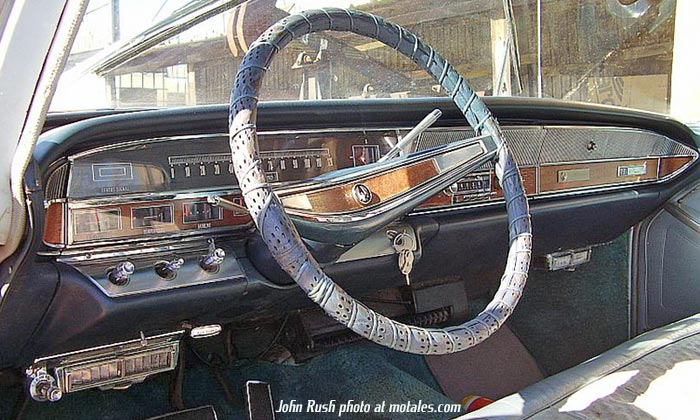Toward the end of 2015, I ran across a store which sells 50-gallon barrels, among other things, on U.S. Highway 79 in Milano, Texas. I asked the owner of the store and the cars for permission to take these photos, and he was happy to talk about them as well.

He bought the 1965 Imperial Crown from an estate in Oklahoma. It fired up on the second crank, and the engine sounds very smooth. He said the points were replaced with an electronic ignition; these and the dual exhaust pipes are, he claimed, the only items that aren’t stock. Even the spare tire is an original 9.15 x 15 bias ply, though one of its seams is separating, and it’s not recommended to use, especially with the radials on it. The hubcaps look more like the heavier ones that were standard with the 1966-69 models than those which were issued for ’65. Were these actually introduced late in the ’65 model year?

This was the last model year for the 413 engine, and the first for the TorqueFlite column shifter, which replaced 1964’s pushbuttons. It was the first year to cover the headlamps with a pane of flat-tempered glass.

The paint isn’t perfect; he talked about repainting it two-tone, with the roof all white. I think that was an original option. The right rear door had a dent that was fixed by a guy who did a poor job on it. He’s wondering where he can find a replacement door.

The interior is complete, including walnut veneer inlays on the steering wheel, dashboard, and doors; a master warning light alerted the driver to any issues with fuel level, oil pressure, or engine temperature. The seats, though not torn, are worn and starting to crack and need re-upholstery. I don’t think the fan belts are a matched set, which used to be common, but it’s hard to find just one in that size these days (66 inches, I think).

Only 18,399 Imperials were made in 1965, in just two lines—Crown and LeBaron. Imperial sales were rarely higher ; this was actually the third highest year for sales to date, and only one year would be better in the future (1969). The body style of the 1965 Imperial, developed under Elwood Engel, was mainly a carryover from 1964. Underneath the Imperial’s skin was a body-on-frame design, likely sharing quite a bit with the pre-1960 models, because the Imperial’s low volume did not justify moving to unibodies with the rest of the Chrysler Corporation cars in 1960. Imperials finally switched over with the 1967 model year; the 1966 Imperial was nearly identical to the ’65, but used a new grille and replaced the 413 V8 with the 440. Powertrains were shared with other big cars in the Chrysler Corporation lineup; from 1961-66, bodies were not. (Some wagons stuck to body-on-frame after 1960, as well, but not as long as the Imperial did.)

The owner said he turned down an offer of $10,000 for the car. I don’t blame him. I'll bet it’s the smoothest-riding road car he’s owned. A very stately vehicle.

The 1960 Valiant is a project car, and I got the impression that he'd accept a reasonable offer or trade for it (he likes Chevy trucks from the ’47 to ’53 model years). The body is straight, but the interior needs work: the floor pans are rusted, and the rear seat and instrument panel are out. It has a 3-speed manual with a floor shifter. I don’t know about the condition of the engine. The badge in the middle of the grille doubles as a hood latch, a clever Valiant feature.

The jack stands are under the bumpers, when they should be under the axles. Even complete, the car isn’t very collectible, though it would make a good driver and is historically significant. The slant six probably returns 30 highway mpg. A different and interesting design.


Jeep is semi-hiding price cuts
Anything but EVs! Stellantis joins vegetable oil vans project
Stellantis nails narcissism, wins award
More fish stories of Mopar cars and trucks
Big Chrysler, Spooky Imperial: Car Spotter #29
Driving a three-on-the-tree 1977-ish Dodge pickup
1970-71 Dodge W300 Power Wagon
Vintage Dodge Bros, Plymouth, and Dinky models
1975 Dodge Charger SE: Comfy but slow cruiser
1957 Plymouth Belvedere Convertible
1940s Dodge pickup: Car Spotter #20
1949 DeSoto Custom: Car Spotter #19
1967 Dodge Coronet 440: Car Spotter #18
Car Spotter #17: 1966 Chrysler 300
Car Spotter: 1950 Plymouth
Car Spotter: Imperial Crown and Valiant
Car Spotter: Dodge D-200 Power Wagon
Car Spotter: Custom Ram Van Minivan
Car Spotter: Mopars of the Hagley Car Show
Car Spotter: C-100 California Pickup
Car Spotter: 1948 Chrysler Windsor and 1940 Dodge at a Newark used car lot
Car Spotter Plymouth Twofer: Belvedere and Horizon
Car Spotter: circa-1970 Dodge C-series medium duty truck
Van Spotter: Daily-driver Dodge B-van
Car spotter: Dodge D-200
Car Spotter: Plum Crazy 1971 Dodge Challenger
Car Spotter: 1971 Plymouth Fury Pursuit Car
Car Spotter: 1914 Dodge Bros. Touring Car
1951 DeSoto: Toothy-Grilled Car Spotter
Copyright © 2021-2025 Zatz LLC • Chrysler / Mopar car stories and history.
YouTube • Editorial Guidelines • Videos